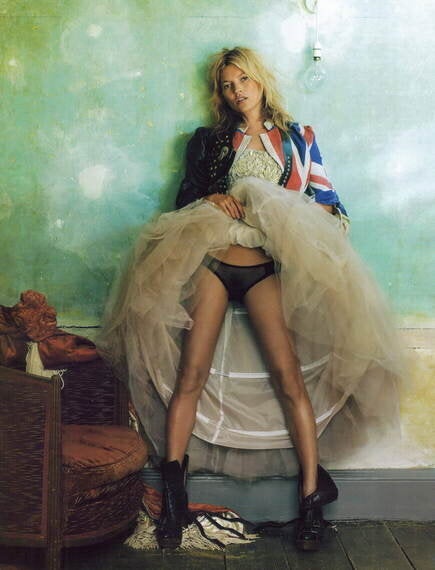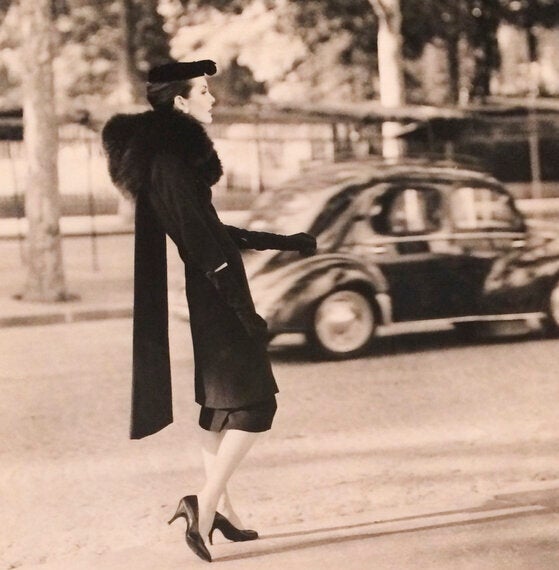
My fascination with taking baths when on photographic shoots or in strange places such as large stately homes, may possibly have derived from viewing an image in an exhibition of Lee Miller in Hitler's bathtub after the war had been declared over. I remember seeing this photo whilst I was at college over 20 years ago and it made me realise the power of a 1000 words that the photograph is. The Vogue centenary exhibition at the National Portrait Gallery doesn't disappoint with this theory and displays of Miller's war work alongside that of Cecil Beaton and at once, whilst I think of this now iconic image, my mind is in awe of the colossal display of photographs from Arnold Genthe (1910) to Mario Testino (current) I am all at sea as to where to begin my review of this fabulous curation by Vogue Contributing Editor, Robin Muir and the design of the exhibition by theatre and opera designer Patrick Kinmonth.
The exhibition begins in the present and takes you back through the years in reverse chronology. Saying this, it will take you a long time to get there, through a vast array of beautifully presented photographs, many working prints and beautifully framed collectors pieces. Transparencies, moving photographs, magazine editions and transcripts from fashion editors adorn the rooms each designed with the era in mind.
What is beautiful about A Century of Style is that it is not only for fashionistas, or photography enthusiasts, it also will appeal to anyone who has an inkling of an interest in culture - whatever age they are - seeing as this exhibition does end up in the 1920's.
Kate Moss by Mario Testino (2008), Alexandre McQueen by Tim Walker (2009) and Boris Johnson by Henry Bourne (2012), make up just a tiny amount of stunning photos of the current era whilst the '80's saw the rise of the super model, punk in the '70's and before this period is where my passion for fashion, culture and photography kick in, the 60's right the way back to the 20's: Norman Parkinson, David Bailey, Albert Watson... the list goes on and on, with over 80 photographers exhibited in these seventeen rooms, and over 280 photographs, it is no surprise that as a photographer I am so completely and wonderfully overwhelmed by the intensity of this incredible show.
Anne Saint Marie in a street in Paris by Henry Clarke (1955), a beautiful black and white photograph that sums up the elegance and Parisian chicn in the '50's and 'For Cars and Clothes A New Dash' by Tony Armstrong Jones (a section of transparencies 1958), the 'bad boy' of the swinging sixties, displayed with immense stature, within the transparency room, with working strips of images marked with china-graph pencil for the final published image projected. A room that kept me locked. Working negatives and trannys are something that has always interested me, it is how a photographer has to think, to be able to visualise the end product whether it is an editorial or an advertising campaign, so this room might have stolen my heart.

Throughout the war, British Vogue continued with photographic titles by Beaton, of 'Fashion is indestructible' and beautiful Land Girl images by Miller. The 20's saw pioneers in photography such as Arnold Genthe (the Modern Torso) and Dorothy Wilding with a photo of Helen Wills Moody an unpublished Vintage bromide from 1927 of the Wimbledon tennis player and the epitome of sporting chic. From 1927 - 1933 Moody did not lose a single set.
A long gallery displays every era of magazine covers and inserts, a special visit is required for this room alone, with the start/ end being the Vogue Library adjoining the 1920's room, you can make your way back through the '30's - in fact, once you are inside this exhibition you could very well just spend the whole day there reminiscing your youth or wondering how your Grandmothers lived and Great Great Aunts spent their days.
British Vogue was founded in 1916, when the First World War made transatlantic shipments of American Vogue impossible and its proprietor, Conde Nast, authorised a British edition. It was an immediate success, and over the following ten decades of uninterrupted production, the magazine continued to mirror its times and put fashion into a wider world - the austerity and optimism that followed the two world wars, the 'Swinging' London scene in the sixties, the radical seventies and the image-conscious eighties. In the magazine's second century, it remains the cutting edge of photography and design.
Vogue 100 A Century of Style continues until May 2016 at the National Portrait Gallery.
(Photos courtesy of National Portrait Gallery Press Office)